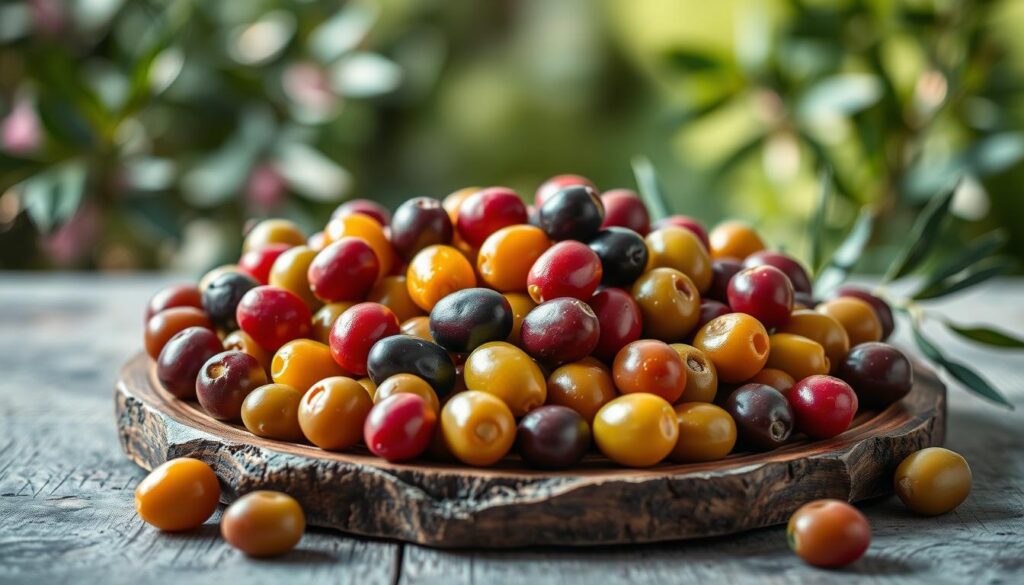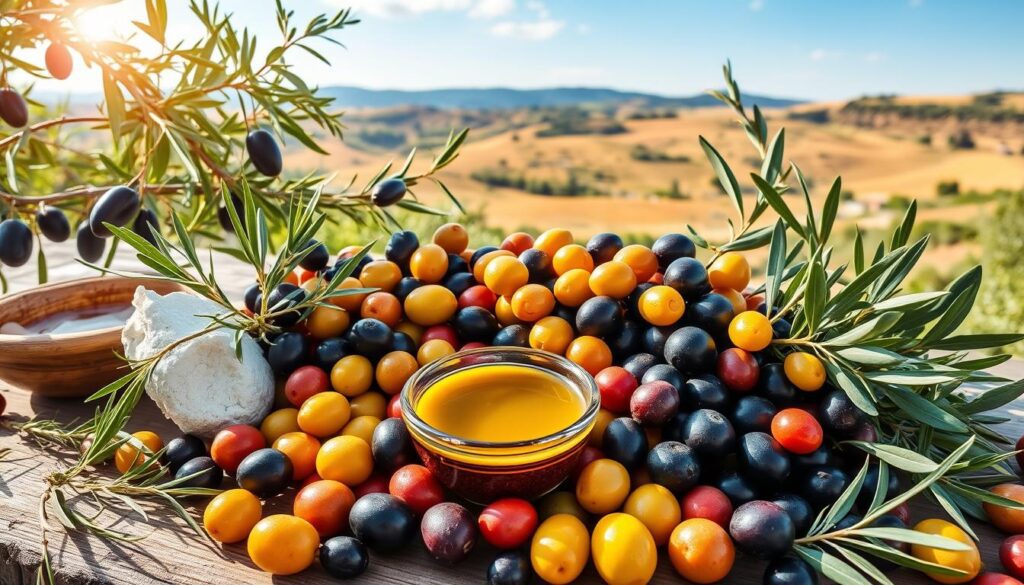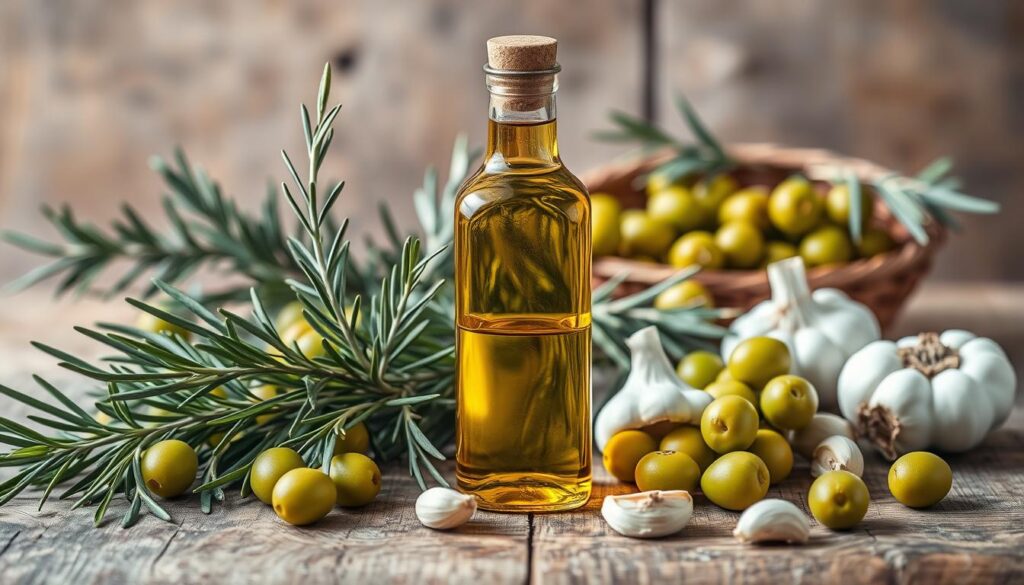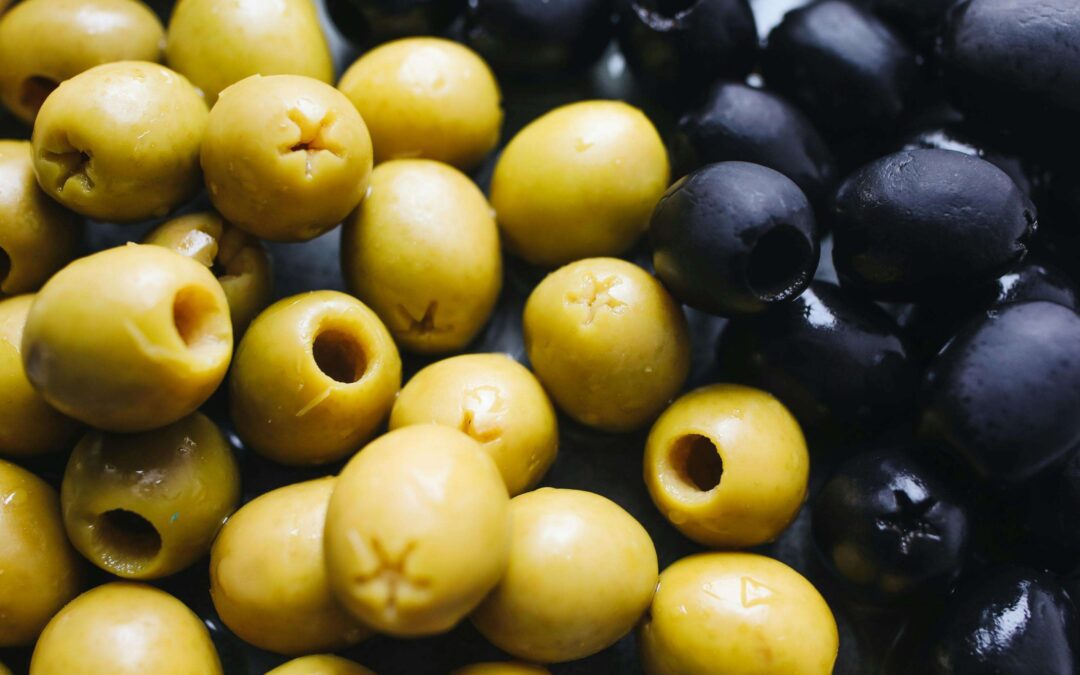Olives are a great snack for staying healthy. They are full of good stuff that helps our bodies. Olives are mostly composed of healthy fats. These fats are good for our hearts and help fight inflammation.
Olives also have vitamin E and antioxidants. These protect our cells from harm. They help lower the risk of serious diseases like cancer and heart disease. Eating olives often can add important nutrients to our diet.
Olives are fun to eat in many ways. We can have them whole, sliced, or stuffed. There are many tasty olive snacks to try, like tapenade and salads.
Olives are also filling. They contain a lot of fiber, which aids our digestion. This can help us feel full and support our weight goals.
Key Takeaways:
- Olives are rich in healthy monounsaturated fats, vitamin E, and antioxidants that support overall health and well-being.
- Antioxidants in olives, such as oleuropein and hydroxytyrosol, may help reduce the risk of chronic diseases like cancer and heart disease.
- Olives are a versatile snack that can be enjoyed in various ways, from whole olives to olive-based spreads and salads.
- The high fiber content in olives promotes digestive health, regulates appetite, and supports weight management goals.
- Incorporating olives into our diet is a delicious and convenient way to boost our intake of essential nutrients and enjoy their numerous health benefits.
Page Contents
- Understanding Olive Varieties
- Nutritional Benefits of Olives
- Heart Health and Olives
- Olives and Weight Management
- The Anti-Inflammatory Properties of Olives
- Olives as Part of a Mediterranean Diet
- The Fiber Content in Olives
- Olive Oil and Its Health Benefits
- Exploring Olive-Based Snacks
- How to Incorporate Olives into Our Meals
- Conclusion: Embrace Olives for Our Health
- FAQs
Understanding Olive Varieties
Olives come in many varieties. Each has its own taste, color, and feel. From bright green Castelvetrano olives to deep purple Kalamata olives, there’s something for everyone. Let’s look at some popular olives and their health benefits.
Popular Types of Olives
Olive types depend on when they’re picked, how they’re cured, and where they come from. Here are some well-known ones:
- Kalamata Olives (Greece): These deep purple olives taste rich, smoky, and fruity.
- Castelvetrano Olives (Italy): Bright green, these olives are mild and buttery.
- Cerignola Olives (Italy): Large and green, these olives are crisp and buttery, great for stuffing.
- Nyon Olives (France): Jet-black, these olives taste mildly bitter and aromatic.
- Niçoise Olives (France): Black, these olives have a strong yet balanced flavor with herbal notes and a hint of licorice.
Nutritional Differences Among Varieties
Olives are mostly the same in nutrition, but there are small differences between green and black ones:
| Nutrient | Green Olives | Black Olives |
|---|---|---|
| Fat | Higher | Lower |
| Carbohydrates | Higher | Lower |
| Fiber | Higher | Lower |
| Sodium | Double | Half |
| Calcium | Lower | Higher |
| Iron | Lower | Higher |
All olive types are full of healthy fats, vitamins, and antioxidants. Eating different olives can add flavor and health benefits to our diet.
There are over a hundred mainstream olive varietals used in table olive and olive oil production worldwide, each varying in size, color, texture, and flavor.
Nutritional Benefits of Olives
Olives are small, oval fruits with a hard, non-edible stone. They are grown in the Mediterranean and California. You can eat them whole, pitted, or use them in cooking.
Green and black olives are both good for you. But black olives have more nutrients. They have more healthy fats, fiber, vitamin E, and polyphenols.
One tablespoon of drained olives has 18 kcal/68 kJ. It has 0.1g protein, 1.8g fat, and 0.6g fiber. They also have 15mg potassium and 10mg calcium.
Olives are high in salt. But they are good for you when eaten in small amounts.
Rich Source of Healthy Fats
Olives are full of healthy fats. About 70% of their fat is oleic acid. This fat is good for your heart.
Studies show eating more monounsaturated fat can help you live longer. This is compared to eating more carbs.
| Nutrient | Amount per 100g |
|---|---|
| Calories | 116 |
| Total Fat | 10.90g |
| Fiber | 1.60g |
| Calcium | 88mg |
| Iron | 6.28mg |
High in Antioxidants
Olives are full of antioxidants like polyphenols. These help fight off free radicals. They can also help prevent aging and diseases.
Oleuropein and hydroxytyrosol in olives offer extra health benefits. These olive antioxidants may protect your heart and blood vessels. More research is needed to know their effects on other diseases.
The Mediterranean diet, which includes olives and olive oil, has been linked to a 28% reduced risk of developing cardiovascular disease when compared to a control diet, based on a study of nearly 26,000 women.
Olives are also low in cholesterol and high in fiber. They have important minerals like calcium and iron. Adding olives to your diet can make your meals tastier and healthier.
Heart Health and Olives
The Mediterranean diet is great for a healthy heart. Olives are a big part of it. They help our hearts a lot.
How Olives Support Cardiovascular Function
Olives are full of good stuff for our hearts. They have hydroxytyrosol, an antioxidant.It increases good cholesterol and helps to reduce bad one.
Olives also have iron, calcium, and vitamins A and E. These help our hearts work right.
The Role of Monounsaturated Fats
Olives are full of monounsaturated fats. These fats are good for our hearts.
Studies show olive oil can lower heart disease risk. This is because of the monounsaturated fats.
It’s important to eat olives in the right amount. They can have a lot of sodium. The CDC says we should eat less than 2,300 milligrams of sodium a day.
| Nutrient | Amount |
|---|---|
| Calories | 25 |
| Fat | 2 grams |
| Carbohydrates | 1 gram |
| Fiber | 0.4 grams |
Knowing what’s in olives helps us eat them wisely. They’re tasty and good for our hearts.
Olives and Weight Management
Olives are great for healthy snacking and weight control. They taste good and are full of nutrients that help us lose weight. Let’s see how olives can help us stay healthy.

Low-Calorie Snack Options
Choosing the right snacks is key for weight management. Olives are a great choice because they are low in calories. A serving of 10 olives has only 35–95 calories.
Olives are also low in calories compared to how many we burn eating them. They have a calorie density of 1–1.5. This, along with their fiber, keeps us full without eating too many calories.
How Olives Can Curb Hunger
Olives are not just low in calories. They also help us feel full and stop cravings. The fats in olives slow digestion and make us feel full.
Studies show that olives can help control hunger. A 60-day study found that eating more monounsaturated fats helped women lose up to 4.2 pounds. This shows how good olives are for weight management.
| Olive Type | Calories per 10 Olives | Monounsaturated Fat Content |
|---|---|---|
| Green Olives | 40-50 | High |
| Black Olives | 50-60 | High |
| Kalamata Olives | 70-80 | Very High |
Adding olives to our diet can help with weight management. Just remember to eat them in moderation. This way, we can enjoy their taste and benefits for our health.
The Anti-Inflammatory Properties of Olives
Olives are tasty and good for you, thanks to their anti-inflammatory powers. A special compound called oleocanthal is found in olives and olive oil. It helps fight inflammation.
Oleocanthal stops our bodies from making inflammatory enzymes. This can help prevent diseases like arthritis and type 2 diabetes. It’s like a natural painkiller, without the bad side effects of medicine.
Olive Oil vs. Whole Olives
Olive oil and whole olives both have oleocanthal, but in different amounts. Extra virgin olive oil (EVOO) has lots of good stuff, including oleocanthal. But eating whole olives gives you fiber, vitamin E, and more.
How Olives Contribute to Reduced Inflammation
The Mediterranean diet, rich in olives and olive oil, is good for you. It lowers the risk of many diseases. This is because of the anti-inflammatory polyphenols in olives and other plants.
- 75% of the fat in olives is oleic acid, which is good for you and helps lower cholesterol.
- One cup of black olives has over 20% of the vitamin E you need. Vitamin E fights inflammation.
- Eating the right fats from olives can also improve your cholesterol levels.
Eating olives and olive oil every day gives you lots of good polyphenols. This helps keep you healthy and fights aging diseases.
Olives as Part of a Mediterranean Diet
The Mediterranean diet is known for making people live longer and feeling better. It focuses a lot on olives. This diet comes from Southern Europe and shows how olives make food tasty and healthy.

Olives have been important in Mediterranean food for thousands of years. People have eaten them for over 10,000 years. Today, they are key in the Mediterranean diet, bringing health benefits and flavor to food.
Key Components of the Mediterranean Diet
The Mediterranean diet is rich in:
- Whole grains and cereals (making up 55-60% of calories)
- Fruits and vegetables
- Legumes
- Nuts and seeds
- Moderate amounts of fish, poultry, and dairy
- Limited red meat and processed foods
Olives and olive oil are at the heart of this diet. They give healthy fats, antioxidants, and polyphenols. These help with health, like living longer and feeling better.
| Nutrient | Health Benefit |
|---|---|
| Monounsaturated fats | Increases longevity, lowers disease risks, and improves brain function |
| Antioxidants (vitamin E, polyphenols, flavonoids) | Less inflammation, keeps bones strong, and protects the heart |
| Fiber | Better digestion and helps with weight |
How Olives Enhance Meal Flavor
Olives make Mediterranean food taste better. They add flavor to salads, sandwiches, pasta, and pizza. Their unique taste goes well with many foods, making them great for the Mediterranean diet.
“Olives are not just a delicious snack; they are a symbol of the Mediterranean way of life – a reminder to slow down, savor our food, and appreciate the simple pleasures in life.” – Anonymous
Adding olives to our meals brings the Mediterranean diet’s flavors and health to our tables. It’s a way to enjoy food like generations have before us.
The Fiber Content in Olives
Olives are tasty and good for us. They have lots of fiber, which helps our digestion. Let’s see how olives can make our gut healthier.
Importance of Dietary Fiber
Dietary fiber is key for a healthy diet. It keeps our digestion regular and helps our gut bacteria grow. Most of us don’t get enough fiber, but olives can help.
Olives and Digestive Health
Olives have about 1.5 grams of fiber in 10 of them. This fiber is good for our gut bacteria. It helps our digestion work better.
The fiber in olives changes with the type. Kalamata olives have 3 grams of fiber in just 5. Eating different types of olives can give us more fiber.
| Olive Variety | Fiber Content per Serving | Serving Size |
|---|---|---|
| Kalamata Olives | 3 grams | 5 olives (38 grams) |
| Green Olives | 1.5 grams | 10 olives |
| Black Olives | 1.5 grams | 10 olives |
Olives also have other health benefits. Some olives, like those fermented naturally, are full of good bacteria. These bacteria help our gut stay healthy.
Eating olives regularly can boost our fiber and help our digestion. They’re tasty and good for us. Enjoy them as a snack or in meals to feel better.
Olive Oil and Its Health Benefits
An essential component of the Mediterranean diet is olive oil. It’s full of good fats and antioxidants. These make it a great addition to our food.

Choosing the Right Olive Oil
Choosing the right olive oil is important. Extra virgin olive oil is the best. The first pressing of olives is used to make it.
It has the most good stuff in it. Look for oils with a strong flavor and smell. This means it’s fresh and good quality.
Here’s a comparison of the nutritional content of different types of olive oil per tablespoon (14 grams):
| Type of Olive Oil | Calories | Total Fat | Saturated Fat | Monounsaturated Fat | Polyunsaturated Fat |
|---|---|---|---|---|---|
| Extra Virgin | 119 | 13.5g | 1.9g | 9.8g | 1.4g |
| Virgin | 119 | 13.5g | 1.9g | 9.8g | 1.4g |
| Refined | 119 | 13.5g | 1.9g | 9.8g | 1.4g |
Culinary Uses of Olive Oil
Olive oil is great in the kitchen. It can be used for frying, baking, roasting, and sautéing. It’s also good on salads, as a bread dip, or in marinades and sauces.
A study involving 7,447 participants showed that dietary changes in the form of a Mediterranean diet with olive oil or nuts achieved significant improvements in carotid artery health, surpassing pharmaceutical interventions.
Using olive oil in our cooking brings many olive oil benefits. It makes our food taste better and is healthier.
Exploring Olive-Based Snacks
Olives are good for you and taste great. They can be turned into many snacks. This lets everyone find something they like.
Olive Tapenade: A Tasty Spread
Olive tapenade is a tasty spread made from olives and more. It’s great on crackers or bread. It’s full of good stuff like healthy fats and fiber.
A 100-gram serving of green olives has:
| Nutrient | Amount per 100g |
|---|---|
| Calories | 145 |
| Carbohydrates | 4 g |
| Dietary fiber | 3 g |
| Protein | 1 g |
| Total fat | 15 g |
| Saturated fat | 2 g |
| Sodium | 1,556 mg |
| Vitamin E | 4 mg (20% DV) |
But, olives have a lot of sodium. A small serving has about 525 mg of sodium.
Stuffed Olives: A Flavorful Treat
Stuffed olives are another tasty snack. They’re filled with things like garlic or almonds. They’re great for snacking or as a garnish.
Green olives are a staple in Mediterranean cuisine and can be found canned, jarred, stuffed, or under oil.
It’s good to remember olives have a lot of fat and sodium. But most of their fat is monounsaturated fat. This fat is good for your heart.
How to Incorporate Olives into Our Meals
Adding olives to our meals is easy and tasty. They are full of healthy fats, antioxidants, and nutrients. With over 200 types of olives, each with its own taste and health perks, there are many ways to add them to our diet.
Simple Snack Ideas
Olives are a great snack because they are low in calories but packed with good stuff. Some top picks for snacking include:
- Kalamata olives: Rich in antioxidants, iron, and vitamin A
- Black olives: Good source of vitamin E, healthy fats, and fiber
- Green olives: Abundant in antioxidants and healthy fats
- Castelvetrano olives: High in vitamin E and healthy fats, with a buttery flavor
Enjoy these olives on their own or with other healthy snacks like veggies, whole-grain crackers, and hummus.
Recipes Featuring Olives
Olives can make any dish taste better and healthier. Here are some tasty olive recipes to try:
- Olive Tapenade: Mix kalamata olives, capers, garlic, lemon juice, and olive oil. Spread it on crackers or bread for a yummy starter.
- Mediterranean Salad: Combine romaine lettuce, cherry tomatoes, cucumber, feta cheese, and olives. Drizzle with olive oil and red wine vinegar for a fresh salad.
- Olive and Tomato Bruschetta: Top baguette slices with cherry tomatoes, black olives, and olive oil. It’s a quick and tasty snack or appetizer.
| Nutrient | Amount per Serving | % Daily Value |
|---|---|---|
| Vitamin E | 0.25 mg | 1.7% |
| Iron | 0.50 mg | 2.8% |
| Vitamin A | 60 IU | 1.2% |
| Fiber | 0.50 g | 2% |
By adding olives to our snacks and meals, we get to enjoy their great taste. We also get health benefits like better heart health, less inflammation, and better digestion.
Conclusion: Embrace Olives for Our Health
Olives are full of good stuff that helps us stay healthy. They have healthy fats, antioxidants, and fight inflammation. We can add them to many foods, making them tasty and nutritious.
Making Olives a Staple in Our Diet
It’s easy to add olives to our meals. There are many types, like green and black olives. We can snack on them, add them to salads, or use them on pizzas and sandwiches.
By eating a few ounces of olives each day, we get their health perks. This way, we don’t eat too much salt or calories.
Final Thoughts on Olive Consumption
Olives are great for our diet. They have good fats, antioxidants, and fight inflammation. This helps our heart, helps us stay at a good weight, and keeps us healthy overall.
Choosing the right olives and eating the right amount is key. Let’s enjoy olives every day. They make our meals better and help us stay healthy.
FAQs
What are the nutritional benefits of olives?
Olives are full of good fats and vitamins. They have vitamin E and antioxidants. These help protect cells and can make your heart healthier.
What are the different types of olives?
There are many types of olives. They can be green or black. Green ones are picked early, and black ones are ripe.
How do olives support heart health?
Olives have healthy fats. These fats can lower bad cholesterol. This is good for your heart. Studies show eating these fats can help. It can make your heart healthier.
Can olives help with weight loss?
Olives are low in calories. They have about 7 calories each. This means you burn more calories eating them than you gain. The fats in olives also make you feel full. This can help you eat less.
What are the anti-inflammatory properties of olives?
Olives have compounds that fight inflammation. These compounds are like ibuprofen. They can help with pain and diseases.
How do olives fit into the Mediterranean diet?
Olives are key in the Mediterranean diet. This diet is full of whole foods and healthy fats. It’s good for your heart and waistline. Olives add flavor to meals. They make the diet more enjoyable.
Are olives a good source of fiber?
Yes, olives have a lot of fiber. They have about 1.5 grams per 10 olives. Fiber is good for your gut. Eating olives can help your digestive health. They make your diet more plant-based.
What are the health benefits of olive oil?
Olive oil is like olives but in oil form. It has healthy fats and vitamins. It can lower bad cholesterol while increasing good cholesterol.
What are some healthy olive-based snacks?
There are many healthy olive snacks. You can make olive tapenade with olives, capers, and olive oil. It’s tasty and healthy. Stuffed olives are also great. Fill them with garlic, almonds, or peppers. These snacks are full of health benefits.
How can we incorporate olives into our daily diet?
It’s easy to add olives to your diet. They can be eaten as snacks or used in recipes. They’re great in salads or as a topping for pizza.

